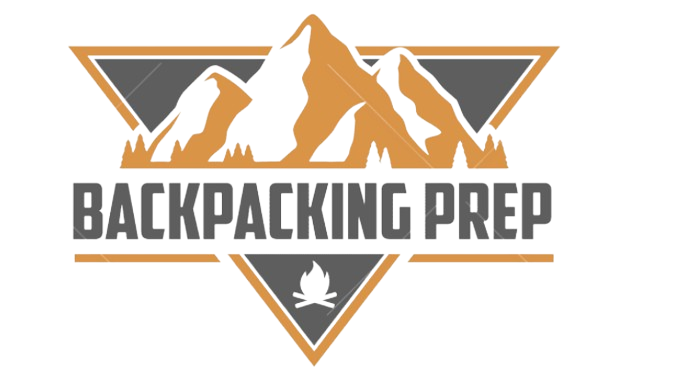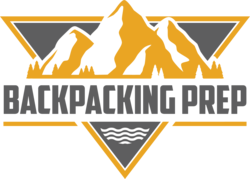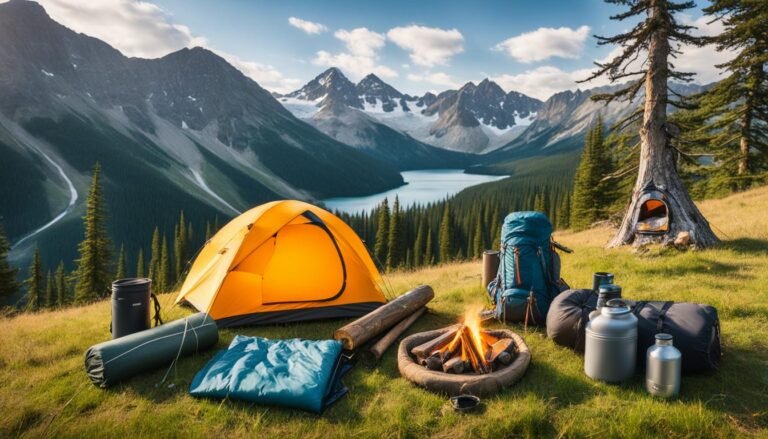Embarking on a backpacking journey thrusts you into the heart of nature, where every item you carry should enhance your outdoor experience. Whether you’re a seasoned hiker or a newcomer to the trails, knowing your backpacking essentials is the first step towards a successful adventure. In the realm of lightweight camping gear, the balance between weight and function becomes crucial.
From the selection of a reliable shelter to the comfort of your sleeping bag, the best camping gear for backpacking is that which reliably supports your journey’s demands without weighing you down. Prepare to delve into the vital equipment that makes your expedition both feasible and enjoyable, ensuring you’re well-equipped for your next foray into the wilderness.
Embarking on a Backpacking Adventure: What to Know
Planning for a backpacking trip involves meticulous attention to your gear selection, dictated by factors like trip duration, location remoteness, and weather forecast. Compiling a backpacking gear checklist is not just about packing; it’s about ensuring self-sufficiency in the wilderness. Below, we outline essential items for your adventure, with a focus on lightweight, versatile, and must-have camping gear. Items critical to your survival and safety are highlighted with an asterisk (*), reminding you of their importance in the Ten Essentials.
| Gear Category | Essentials | Notes |
|---|---|---|
| Navigation* | Map, compass, GPS device | Electronic devices should have extra batteries or charging methods. |
| Shelter* | Tent, tarp, bivy, or hammock | Season and environment appropriate with necessary stakes and guylines. |
| Sleep System* | Sleeping bag and pad | Choose according to the lowest temperatures expected. |
| Cookware | Stove, fuel, and cookset | Ease of use and reliability are key; always bring a backup fuel source. |
| Hydration* | Water bottles and treatment system | Account for the availability of water sources along your route. |
| Nutrition* | High-energy, lightweight food | Minimum one extra day’s worth of food recommended. |
| Illumination* | Headlamp or flashlight | LED lamps with spare batteries preferred due to longevity. |
| First Aid* | First aid kit | Customize to your group size, trip length, and personal needs. |
| Repair Tools* | Multi-tool, gear repair supplies | Include duct tape, sewing materials, and other quick-fix items. |
| Fire* | Matches, lighter, tinder | Waterproof matches and fire starters can be a lifeline in wet conditions. |
To keep pace with the evolving world of backcountry exploration, stay rigorously informed about the latest in camping gear essentials for backpacking. Manufacturers are constantly innovating, so an up-to-date gear checklist can dramatically enhance your comfort and safety outdoors. Remember, the right gear can make the difference between a trying ordeal and an unforgettable journey into nature.
Lastly, as you assess each piece of gear, consider its role in your overall experience. Lighten your load where you can, but never at the expense of your safety or ability to enjoy the trails. After all, backpacking is about finding that ideal balance between the weight of your pack and the depth of your adventure.
Choosing the Right Backpack: Size & Features
When venturing into the wilderness, the importance of selecting the optimal outdoor gear for backpacking cannot be overstated, with your backpack playing a pivotal role. It’s more than just a bag; it’s your mobile basecamp. The right backpack marries size and features to serve the changing demands of various camping gear for wilderness trips. Below, we delve into the essentials of backpack fitting, load management, and protection from inclement weather.
Finding Your Fit: Adjustability and Comfort
The key to a comfortable hike lies in a backpack that’s tailored to fit your body. An ill-fitting pack can turn a thrilling journey into a challenging ordeal. Look for backpacks that offer adjustable straps and hip belts to conform to your unique frame, ensuring weight is evenly distributed across your hips and shoulders to mitigate fatigue.
Capacity Demands: Balancing Load and Trip Duration
Planning the duration of your excursion is critical when it comes to determining the volume and weight you’ll be carrying. A weekend jaunt may only require a backpack with a 30-50 liter capacity, whereas extended treks call for larger packs. Strive to find the sweet spot where carrying your backpacking essentials doesn’t compromise your ability to travel freely.
Weatherproofing Essentials: Keeping Gear Dry
No outdoor adventure is immune to weather’s fickle nature. The right backpack must include features such as a built-in rain cover or water-resistant materials. The assurance that your camping gear remains dry is paramount, as wet gear can be a recipe for discomfort, or worse, hypothermia.
| Backpack Feature | Benefit |
|---|---|
| Adjustable Straps | Ergonomic weight distribution |
| Hip Belt | Support and stabilization |
| Volume Capacity | Ensures ample space for essentials |
| Material and Build | Durability in rough conditions |
| Rain Cover | Keeps contents dry in wet weather |
Whether it’s a brief foray into the wild or an extended wilderness journey, backpacking necessitates meticulous selection of gear. A harmonious blend of comfort, capacity, and weather resistance in your backpack can greatly enhance your outdoor escapades.
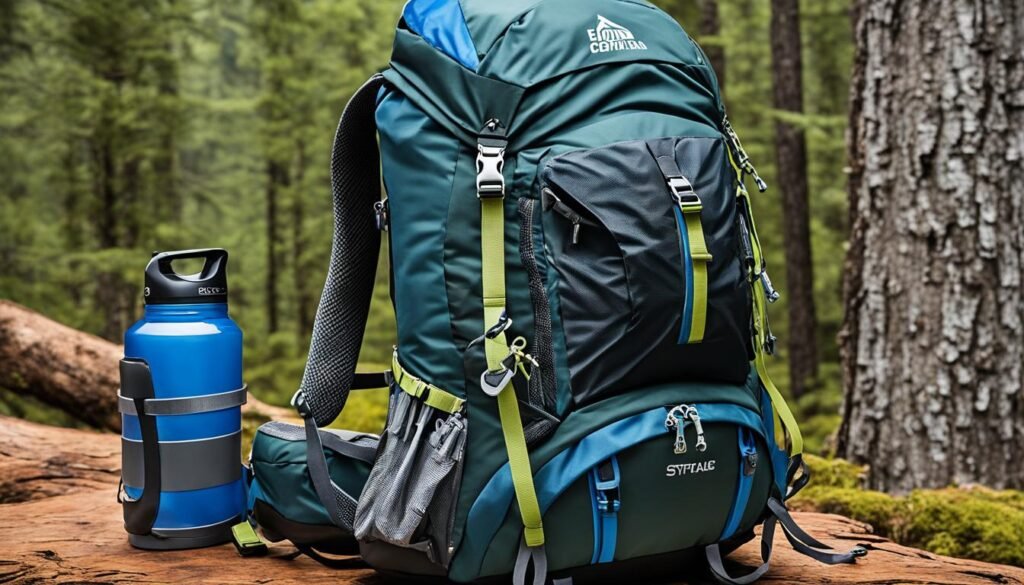
Footwear for the Trails: Selecting Hiking Boots and Shoes
When it comes to traversing the great outdoors, the importance of selecting the right footwear cannot be understated. With the variety of terrains and conditions one may encounter on backpacking expeditions, a hiker’s shoes or boots act as critical tools for endurance and safety. Your choice in footwear is integral to your backpacking gear checklist, not just as must-have camping gear, but as part of the best camping gear for backpacking that you can invest in.
Matching Footwear to Terrain
The diverse landscapes you’ll meet call for footwear that’s been meticulously matched to your trail’s conditions. Whether you’re facing rocky paths, muddy routes, or slippery slopes, each requires boots or shoes with features designed to tackle these specifics.
Importance of Support and Breathability
As you accumulate miles on your journey, the value of support in your footwear becomes abundantly clear. Adequate ankle support can prevent sprains, and breathable materials keep your feet dry, thwarting the discomfort of blisters and hotspots.
Breaking In Your Boots Pre-Trip
Nothing disrupts an adventure like a pair of boots that haven’t been properly broken in. Before setting out, wear your boots on shorter treks to mold them to your feet’s shape, which will pay dividends in comfort and enjoyment on your backpacking adventure.
| Terrain Type | Footwear Features |
|---|---|
| Rugged / Mountainous | High ankle support, aggressive tread patterns |
| Wet / Marshy | Waterproof materials, quick-draining design |
| Desert / Dry | Highly breathable, lighter colors to reflect sun |
| Snow / Ice | Insulated, can be used with crampons if needed |
Navigating Shelter Options: Tents and Alternatives
When assembling your backpacking gear checklist, one of the most critical decisions revolves around selecting the right shelter. This choice is not just about comfort but about surviving the elements. Whether you’re an ultralight aficionado or a comfort-driven camper, the market offers a range of lightweight camping gear aimed at enhancing your outdoor sleeping arrangement.
The traditional tent stands as a go-to shelter, providing a cozy haven from wind and rain. However, with the advent of camping gear recommendations leaning towards lighter packs, more backpackers are now considering alternatives such as bivy sacks and hammocks.
- Traditional Tent: Ideal for most conditions, with options ranging from simple to fully-featured models boasting rain-fly layers, vestibules, and interior pockets.
- Bivy Sack: A minimalist’s dream that offers a snug, cocoon-like shelter for a solitary traveler looking to save on pack weight and space.
- Hammock: Perfect for woodland adventures, a hammock gets you off the ground, requires no flat space for setup, and provides a comfortable sleep if rigged correctly.
- Tarp: Tarpaulins are versatile and can be pitched in various ways to protect against precipitation and wind, though they require some skill to set up efficiently.
Let’s consider the essentials for a good shelter: durability to withstand harsh conditions, ease of setup, and adequate space. Regardless of your choice, ensure that the item integrates seamlessly with your other gear and does not become cumbersome during your trek. Essential factors such as the season, terrain, and personal comfort should guide your selection to secure a pleasant and safe outdoor experience.
In conclusion, your shelter choice is a pivotal item on your backpacking gear checklist, crucial to both your comfort and safety. Weighing the merits of traditional tents against lightweight and compact alternatives will determine the best fit for your adventure style. Heed the camping gear recommendations and consider the balance between comfort, weight, and simplicity to ensure a restful night under the stars.
Camping Gear Essentials for Backpacking
For many wilderness enthusiasts, creating a comprehensive camping equipment checklist is the cornerstone of a successful backpacking adventure. The right selection of lightweight, versatile, and reliable gear can bolster confidence and comfort as you venture into nature. Whether you’re scaling crisp mountain ridges or trekking through lush forest trails, being equipped with the necessary camping gear essentials for backpacking ensures you are prepared for whatever the great outdoors throws your way.
Lightweight Camping Gear: Striking the Weight-to-Utility Balance
Selecting gear that strikes a fine balance between weight and utility can significantly enhance your backpacking experience. It’s essential to evaluate the significance and function of each item on your list, ensuring that the weight of your pack doesn’t compromise your agility and endurance during the journey.
Outdoor Gear For All Seasons: Adapting to Weather
An important aspect of a camping gear essentials for backpacking checklist is adaptability to various climates. From scorching suns to unexpected squalls, your gear should be versatile enough to shield you and keep you comfortable in unpredictable weather.
Camping Gear Recommendations: Trusted Brands and Products
Experienced backpackers often rely on products from trusted brands, known for their durability and performance. It’s widely advised to integrate these recommendations into your personal checklist, considering your unique needs and preferences along with the collective wisdom of the backpacking community.
| Equipment Category | Item | Typical Use | Weight Range | Recommended Brands/Products |
|---|---|---|---|---|
| Sleep system | Sleeping bag and pad | Overnight warmth and comfort | 1-4 lbs | Therm-a-Rest, Western Mountaineering |
| Shelter | Tent or hammock | Protection from elements | 2-5 lbs | Big Agnes, ENO |
| Cookware | Stove and utensils | Meal preparation | 1-2 lbs | Jetboil, MSR |
| Clothing | Layered apparel | Adaptable to changing conditions | Varies | Patagonia, Arc’teryx |
| Backpack | Multi-day pack | Cargo carrying | 2-5 lbs | Osprey, Gregory |
| Navigation | GPS/Compass | Route finding | Lightweight | Garmin, Suunto |
| Hydration | Water filters/purifiers | Water treatment | Lightweight | Sawyer, Platypus |
| Emergency | First aid kit | Safety and injury response | Under 1 lb | Adventure Medical Kits |
Remember, a thorough backpacking essentials assessment prior to your trip can be the difference between a memorable journey and a challenging ordeal. Choose wisely, pack efficiently, and let your spirit for adventure be your guide.
Sleeping Systems: Bags and Pads for Outdoor Slumber
Ensuring a restful night’s sleep under the stars is crucial for any wilderness adventurer. High-quality sleeping systems are a linchpin in one’s collection of must-have camping gear, particularly when facing the unpredictable nature of outdoor excursions. A well-chosen sleeping bag and pad can be the difference between rejuvenation and exhaustion during your outdoor expeditions.
Understanding Sleeping Bag Temperature Ratings
When nights fall cold and the wilderness whispers, a sleeping bag with the right temperature rating is your first line of defense. The temperature rating of a sleeping bag indicates the lowest temperature at which it will keep a sleeper warm. As an essential part of your camping gear for wilderness trips, look for a bag that’s rated for the lowest temperature you expect to encounter. Remember, these ratings assume that the sleeper is wearing a layer of clothing and using a sleeping pad underneath.
The Role of Sleeping Pads in Comfort and Insulation
Sleeping pads are more than just a cushion between you and the ground; they are pivotal for thermal efficiency, granting much-needed insulation from the chilly ground. By trapping air, they reduce heat loss and increase warmth, a feature not to be overlooked when selecting your best camping gear for backpacking. Pair your sleeping bag with a pad that offers the appropriate R-value, a measure of thermal resistance, for your chosen camping environment.
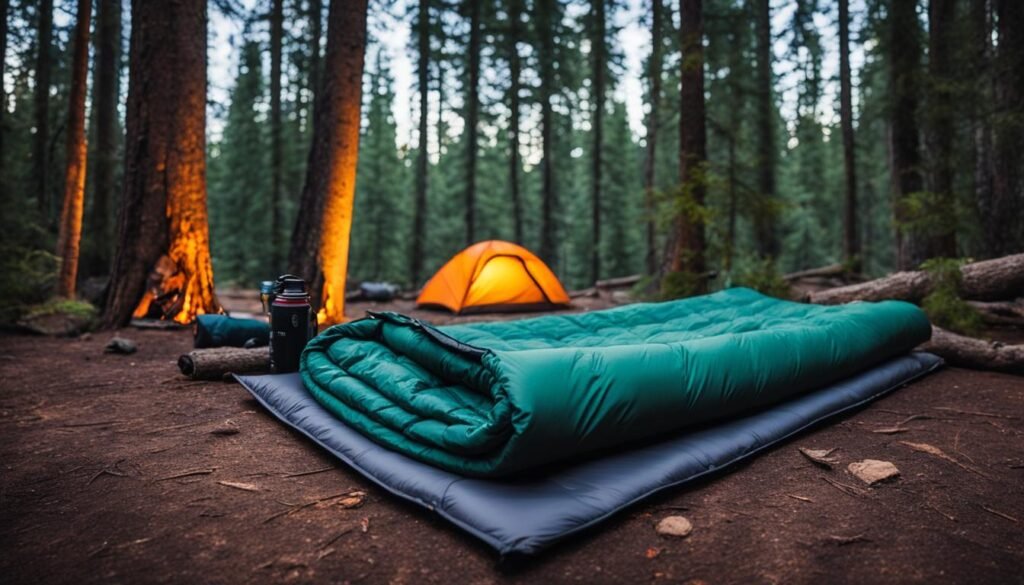
- Opt for a sleeping bag that complements the climate and fits snugly to maximize heat retention.
- Consider the weight and packability of your sleeping system; lightweight and compressible gear can significantly lighten your load.
- Look for sleeping pads with a higher R-value for colder conditions, as they provide better insulation.
Whether you’re an avid mountaineer or a casual trekker, integrating these components into your camping itinerary ensures that you’ll have the essential gear needed for a warm and peaceful outdoor slumber.
Backcountry Cuisine: Kitchen Supplies and Food Planning
Mastering the art of backcountry cuisine begins with the essentials: outdoor gear for backpacking tailored for food preparation. A systematic backpacking gear checklist that highlights the importance of nutrition and efficient cooking is crucial when venturing into the wild.
When discussing camping gear essentials for backpacking, the conversation inevitably turns to the selection of a portable stove. The type of stove selected should reflect the environment and the energy needs of your journey. Once the stove question is settled, the focus must shift to the cookware and utensils that form an efficient backcountry kitchen set-up.
| Item Category | Considerations | Examples |
|---|---|---|
| Stove & Fuel | Weight, efficiency, and type of fuel | Canister stove, alcohol stove, solid fuel stove |
| Cookware | Material (aluminum, titanium), non-stick vs. regular, set vs. individual pieces | Pots, pans, kettle |
| Utensils | Durability, weight, functionality | Spork, foldable knife, long spoon (for freeze-dried meal bags) |
| Cleanup | Eco-friendliness, compactness | Biodegradable soap, compact dishcloth, scrubber |
| Food Storage | Bear-proof containers, odor-proof bags, collapsibility | Bear canister, reusable zip-lock bags |
Let’s delve into the nutritional strategy for the trails. The goal is to pack lightweight and calorie-dense food options that provide the necessary energy to sustain your backpacking excursion. A blend of packaged freeze-dried meals and thoughtfully prepared dehydrated components ensures variety and enjoyment in your outdoor meals. Remember to always incorporate an extra day’s supply as a safety margin for unforeseen delays.
- Dehydrated vegetables and fruits
- Instant grains and legumes
- Jerky and dried meats
- Nuts and seed mixes
- Energy bars and gels
The importance of camping gear essentials for backpacking extends to every meal enjoyed on the trail, from the warming sip of morning coffee to the satisfying dinner beneath the stars. Smart planning, matched by the right gear, will ensure you savor every bite of your backcountry adventure.
Hydration Essentials: Water Filtration and Containers
As you venture into the serenity of the wilderness, maintaining proper hydration is not just a matter of comfort, but of safety. In this segment, we’ll dive into the critical choice between filters and purifiers for ensuring safe drinking water, along with practical tips for efficiently carrying your most precious resource—water. Picking the best camping gear for backpacking includes judiciously selecting the equipment to meet your hydration needs, as undrinkable water can quickly jeopardize an exhilarating adventure.
Choosing Between Filters and Purifiers
Backpackers must decide whether filters or purifiers will best serve their journey. While filters rid water of bacteria and protozoa, purifiers go a step further, eliminating viruses too. Your decision hinges on destination and water source reliability. Filters like the Sawyer Squeeze or the MSR Miniworks are adept in North American backcountry waters, but international trekking often requires the virus-eliminating power of a purifier, such as the SteriPEN Ultraviolet Purifier.
Staying Hydrated: Capacity Concerns for Backcountry Travel
Equally important is how much water to carry, and what containers to use. There is a fine balance between carrying enough to stay hydrated and overburdening yourself. A mix of hydration bladders, like the Osprey Hydraulics reservoir, and durable water bottles, such as Nalgene, provides a versatile solution. On extended trips or in areas where water is scarce, collapsible containers are indispensable for maximizing capacity without sacrificing space.

| Product | Type | Weight | Ideal Use |
|---|---|---|---|
| Sawyer Squeeze | Filter | 3 oz | Backcountry trails, low-risk areas |
| MSR Miniworks EX | Filter | 16 oz | Extended backpacking, murky water sources |
| SteriPEN Ultra | Purifier | 4.8 oz | International travel, virus-concerned areas |
| Osprey Hydraulics Reservoir | Container | 10.6 oz | Hands-free hydration, easy packing |
| Nalgene Wide-Mouth | Container | 6.2 oz | Everyday use, car camping, day hikes |
Clothing for the Backcountry: Layering for Varying Conditions
When embarking on a backpacking journey, a key factor in your backpacking gear checklist is layering your clothing properly. Layering is not just a reliable method for dealing with the unpredictable elements, but it also allows you to manage your body temperature effectively, ensuring you are not too hot or too cold at any given moment. To maintain comfort and safety in the wilderness, it is important to consider lightweight camping gear that serves multiple purposes and doesn’t weigh you down.
Base layers form the foundation of your outdoor attire, due to their moisture-wicking capabilities, keeping you dry as you hike. As we move outward, the insulating mid-layers, such as fleece or lightweight down jackets, retain body heat without adding bulk. An essential component to any must-have camping gear list includes a weatherproof outer layer that shields you against wind and rain.
Here is a breakdown of the layering system, ensuring you’re prepared for whatever conditions the backcountry presents:
| Layer | Characteristics | Examples |
|---|---|---|
| Base Layers | Breathable, moisture-wicking materials like merino wool or synthetic blends that sit close to the skin. | Long-sleeve shirts, leggings, moisture-wicking undergarments. |
| Mid-Layers | Insulating materials that trap heat, such as fleece, down, or synthetic insulation. | Fleece jackets, lightweight down sweaters, wool sweaters. |
| Outer Layers | Weather-resistant or waterproof materials that protect against the elements. | Rain jackets, windbreakers, soft-shell jackets. |
| Additional Layers | Extra items for extreme cold, including insulated pants, gloves, beanies, and thermal socks. | Thermal underwear, insulated gloves, neck gaiters, warm hats. |
Remember, when considering your lightweight camping gear, each layer should provide functionality while adding minimal weight to your pack. Always ensure that you can peel off layers when active and pile them on during rest periods or when the temperature drops. Avoid cotton at all costs, as it holds moisture and can lead to a rapid loss of body heat.
Pro tip: For efficiency, store your layers in accessible compartments of your backpack for quick changes. This helps maintain your body’s comfort level, letting you enjoy your adventure to the fullest.
By understanding and employing these layering principles, you’ll be well-equipped to face the shifting conditions of the backcountry, keeping your focus on the trails instead of your attire.
Safety and Emergency Preparedness in the Wilderness
When venturing into the wild, the line between adventure and adversity can often hinge on the gear you carry. Understanding the criticality of safety and emergency preparedness is not just a part of trip planning; it’s a commitment to returning home safely. Your camping equipment checklist, brimming with outdoor gear for backpacking, isn’t complete unless it addresses the unexpected with backpacking essentials designed for safety.
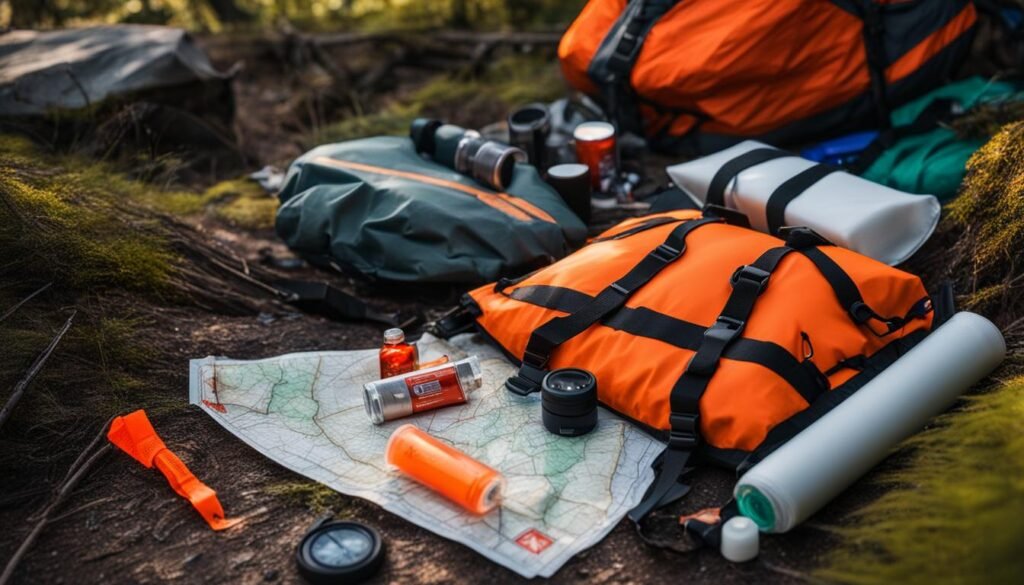
The wilderness is unforgiving, and being equipped with the right gear and knowledge can turn a potential disaster into a managed situation. Before you head out, make sure to review your backpacking essentials list with a focus on these safety and emergency considerations.
The Ten Essentials: Non-Negotiable Items for Any Trip
Known among outdoor enthusiasts, the Ten Essentials list serves as a guide for basic survival items needed in the outdoors. Each element reflects the accumulated wisdom of past adventurers and serves as a safety net when facing the uncertainties of nature. It’s imperative that these items find their way into your pack:
- Navigation (map and compass)
- Sun protection (sunglasses and sunscreen)
- Insulation (extra clothing)
- Illumination (headlamp or flashlight)
- First-aid supplies
- Fire (waterproof matches, lighter, or a stove)
- Repair tools and kit
- Nutrition (extra food)
- Hydration (extra water)
- Emergency shelter (tent or bivy sack)
This list can be the difference between enduring and enjoying your time in the woods, mountains, or other remote locales.
Navigation Tools: From Compass to GPS Technology
No piece of equipment is a substitute for knowledge. Familiarize yourself with traditional, fail-safe navigation tools like a compass or a map. However, in an era where technology offers convenience and added safety, backpackers can supplement their skills with advanced GPS devices. These electronic tools can prove invaluable when trails become indistinct, when weather obscures natural landmarks, or when an emergency exit route is needed.
Emergency Communication: When Technology is Vital
The sound of a whistle may carry across valleys and above the cacophony of rushing rivers. Yet, certain emergencies require the dependability of technology. In remote areas or under dire circumstances, devices such as satellite messengers or personal locator beacons can mean the difference between swift rescue and prolonged exposure. Crucial contact points could be your lifeline to the outside world.
| Emergency Item | Use Case | Recommended For |
|---|---|---|
| Whistle | Signaling for help | All trips |
| Compass | Basic navigation | Trips in well-defined trail systems |
| GPS Device | Detailed navigation and tracking | Remote backcountry, unfamiliar territory |
| Satellite Messenger | Two-way communication, SOS alerts | Extended trips, areas without cell service |
| Personal Locator Beacon (PLB) | One-way emergency signaling to rescue services | High-risk adventures, extreme remoteness |
By packing with these important considerations in mind, you ensure that your outdoor adventures are as safe as they are memorable. Whether you’re refining your camping equipment checklist or curating your collection of outdoor gear for backpacking, make no compromises on your safety essentials — they’re as crucial as the backpack on your shoulders and the trail at your feet.
Conclusion
As our exploration of backpacking essentials reaches its end, one thing remains clear: a meticulously crafted backpacking gear checklist is the beating heart of any well-prepared adventure. The memories we create while immersed in the grand tapestry of nature are vivid, but the success of our endeavors often hinges on the gear we carry. It’s that careful balance of necessity and function that shapes a trip into something truly remarkable. Not just a journey through the wilderness, but a journey into our own resourcefulness and adaptability.
Camping Equipment Checklist Review: Ensuring Nothing is Left Behind
Whether you’re navigating mountain ridges or tracing the spine of a tranquil forest trail, the confidence of being prepared is unmatched. That’s why before stepping outside the comfort of familiarity, going over your camping gear essentials for backpacking is not just wise—it’s indispensable. This checklist serves as a guardian, ensuring that each must-have camping gear item secures a spot in your pack. From ultralight stoves to that trusty weatherproof jacket, every item has a role, a purpose, a promise to keep you pressing forward.
Personal Experiences and Takeaways in Backpacking
Personal tales from the wild serve as the finest guide in curating your equipment list. Each mile trekked, each vista gazed upon, adds a layer of insight into what constitutes the best camping gear for backpacking. With every subsequent adventure, your gear list evolves, shedding redundancies and embracing essentials. The wilderness is both teacher and test, and as we listen and learn, our backpacks grow lighter but our experience richer. In this culmination of trial and tested truths, one finds the joy of backpacking—unencumbered and fully alive.
